In October, Lima blends the ancient with the modern, as daily life pauses briefly to honor a tradition that has endured for centuries.
The Month of Nazareth begins in Lima on October 1st. The Peruvian capital transforms to the rhythm of Creole music as it celebrates the Señor de los Milagros (Lord of Miracles), one of the country's most significant and large-scale religious festivities, recognized as part of Peru's Cultural Heritage.
The image of the crucified Christ, painted in the 17th century by an Angolan slave brought to Peru, has been revered ever since it miraculously withstood a devastating earthquake in 1746.
Throughout October, thousands of faithful followers join processions through the streets of Lima.
The platform bearing the image of the Cristo de Pachacamilla (Christ of Pachacamilla) —a heavy wooden structure— is carried on the shoulders of porters dressed in purple habits, the signature color of this celebration.
Amid incense, music, and local delicacies, join us on this journey of tradition and devotion.
Pure Faith
Several key roles uphold the traditional processions devoted to the Lord of Miracles.
Leading the way are the sahumadoras (incense carriers), who walk ahead of the procession, scattering incense to purify and prepare the path for the sacred image. Their fragrant smoke creates an atmosphere of reverence and solemnity.
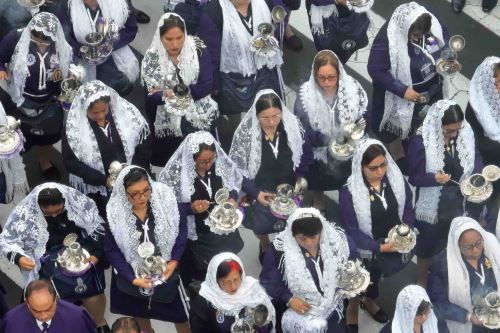
The brotherhood is responsible for carrying the heavy platform that holds the image of the Lord of Miracles on their shoulders.
Organized into teams, they perform this duty with deep respect, as carrying the platform symbolizes their faith and gratitude for the miracles they have received. Their effort is a proud sacrifice they share as part of their devotion.
Meanwhile, the stewards organize and coordinate the processions and other religious activities. They are responsible for maintaining order, managing resources, and ensuring that every detail is in place for a flawless celebration.
Finally, the devotees include everyone from those who faithfully attend the processions in traditional purple or white habits to those who follow the image from their homes, lighting candles and praying.
Their participation encompasses promises and acts of faith, such as prayers, fasting, or attending Mass, all as a sign of gratitude for the blessings they have received.
A Bit of History
The Lord of Miracles has two main images central to his devotion.
According to historian Ruben Vargas Ugarte, the most renowned is the original image painted on an adobe wall in 1651 by an Angolan slave named Pedro Dalcon, located on the main altar of the Sanctuary of the Nazarenas. This image depicts the crucified Christ and is venerated by millions of faithful followers.
The second image, a replica of the original, is the one carried on the processional platform during the traditional October processions. Dating back to 1687, it features the crucified Christ on one side, while the back showcases the image of the Virgin of the Cloud, highlighting the Marian devotion that also plays a significant role in this celebration.
According to Vargas Ugarte in "Historia del Santo Cristo de los Milagros" (History of the Holy Christ of Miracles), the brotherhood of the Lord of Miracles was established on November 2, 1878, under the name Hermandad de Cargadores y Sahumadoras del Señor de los Milagros (Brotherhood of porters and incense carriers of the Lord of Miracles).
This brotherhood included both men and women, who not only accompanied the Lord during his annual procession but also supported one another by contributing a fee to create a common fund.
In 1911, the ecclesiastical authority approved its regulations, and by 1920, the institution was officially recognized, gaining legal status. It received ecclesiastical recognition in 1955.
Currently, the brotherhood consists of some 20 groups of brothers and sisters, along with the group of incense carriers, the group of singers, and a branch of honorary members. It is overseen by a general directory, and its legal representative is the general steward, who is appointed by the Archbishop of Lima.
Beyond the Processions
In addition to the large processions, numerous other activities take place in Lima throughout October to honor the Lord of Miracles. These events encompass religious, cultural, and social activities.
Here are some of the most notable:
Masses and novenas: While the Lord of Miracles processions take place over five days, the remaining days see novenas and vigils held inside the Church of the Nazarenas. During these gatherings, the faithful pray in an atmosphere of profound devotion. It is noteworthy that in October, Mass is celebrated almost every hour, from six in the morning until nine at night.
Religious songs: Music plays a significant role during this month. In addition to the pieces performed by a band during the processions, religious songs stand out, especially those sung by the singers. Among these, the "Hymn to the Lord of Miracles," composed in 1954 by Isabel Rodriguez Larrain, has become a beloved tradition.
Offerings and altars: In various neighborhoods of Lima, the faithful prepare altars and offerings in their homes, along the streets, or in small improvised chapels to honor the Lord of Miracles as he passes through their areas. These altars are beautifully adorned with flowers, candles, and purple flags, creating a serene atmosphere of spiritual reflection.
Turron, Anticuchos, and other Delicacies
During October in Lima, culinary traditions take on special significance, with Turron de Doña Pepa, Anticuchos, and Picarones standing out as three of the most representative dishes.
Turron has a history that dates back to colonial times, centered around a brown slave named Josefa Marmanillo, known as Doña Pepa. She was miraculously cured of paralysis in her arms after praying to the Lord of Miracles.
Thus, Turron de Doña Pepa consists of bars of crunchy dough, coated in fruit honey and decorated with colorful candies. It is primarily consumed in October as a sign of devotion and is closely associated with gratitude for the miracles attributed to the image of the Christ of Pachacamilla.
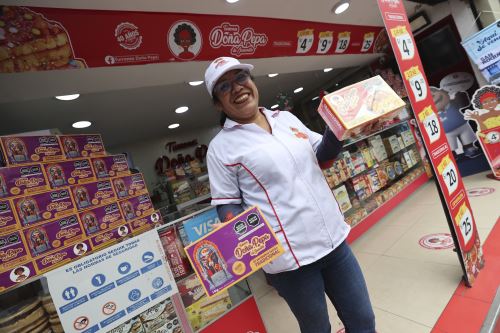
On the other hand, Anticuchos are a traditional dish that gains prominence during this month. These flavorful pieces of beef heart, marinated and grilled on skewers, are sold on the streets of Lima, particularly near the processions.
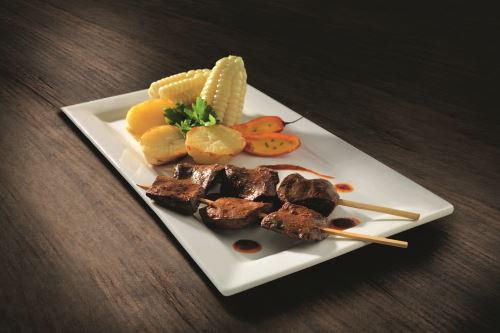
Its aroma fills the avenues where the faithful and spectators gather, making it an essential gastronomic experience during the celebration of the Lord of Miracles. This dish, with pre-Hispanic origins and African influences, is an integral part of Peru's cultural heritage.
Finally, Picarones, a dessert with viceroyal origins made from flour, pumpkin, and sweet potato, are the perfect way to end any meal in October. Served with panela honey, they are especially popular during the festivities.
Like Anticuchos, Picarones are commonly sold at street stalls during the processions. The delightful sweetness of Picarones has made this dessert a culinary icon not only in October but also during other Peruvian festivities.
About the Museum
The Lord of Miracles Museum, located just half a block from the Church of the Nazarenas in Lima, is dedicated to preserving and sharing the history and devotion surrounding the venerated image of the Christ of Pachacamilla.
This museum features an extensive collection of religious artifacts, including a faithful replica of the original wall of the Lord of Miracles, located at the entrance of the museum.
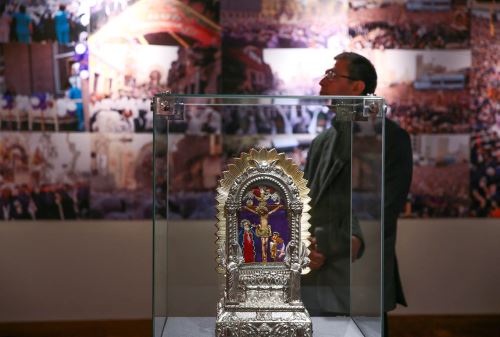
Visitors can also find ornaments used in the processions over the years, along with historical photographs that document this profound devotion. Additionally, there is a display known as "the wall of graces received," where visitors can see testimonies of blessings attributed to the Lord of Miracles.
The processions of the Lord of Miracles not only mobilize faith but also life in Lima. Some main streets and avenues are temporarily closed to make way for the crowd of devotees, while stores in Lima Center are also influenced, as many take advantage of the increase in visitors to offer products related to the festivity.
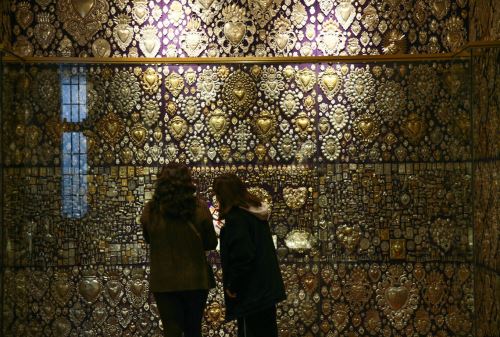
Editor's note: Information provided by PromPeru via peru.info / Images provided by Andina News Agency and PromPeru
(END) NDP/MVB
Publicado: 31/10/2024